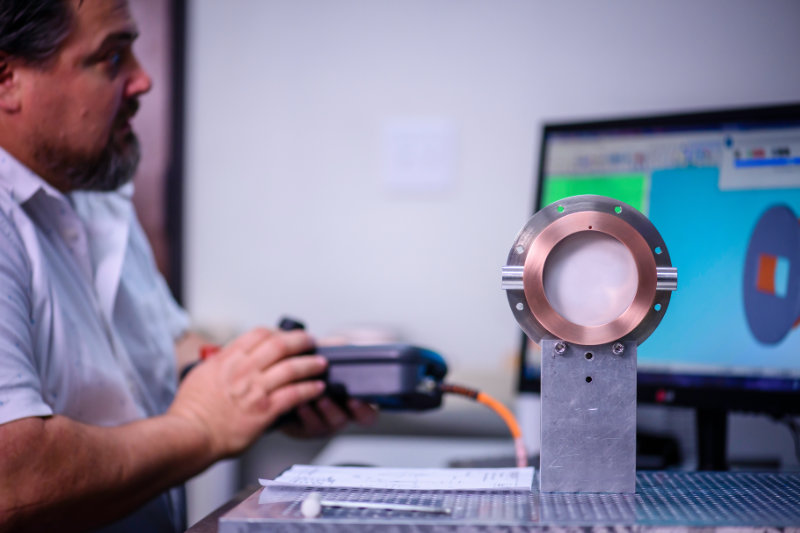
Metallization vs. Active Alloy Brazing
Applications for brazing ceramic to metal are most commonly found in microwave tube, semiconductor feedthru and laser devices, where high vacuum integrity and dielectrical properties are required. More recently, medical and military devices have brought forward new demands for ceramic to metal seals, which require biocompatibility and high joint strength.
The difficulty in brazing ceramics to metals is largely due to the inability of most braze alloys to “wet” directly to ceramic materials and the accumulation of residual stress once the materials have been successfully “wetted”. The three contributing factors for successfully brazing ceramics to metals are material selecetion, joint design and wettability.
Material Selection
Metals are generally selected based on their CTE (Coefficient of Thermal Expansion) value. In general, the ceramic and metal being bonded should have CTE values which are as close as possible. However, the yield strength of almost any metal can be lowered by reducing its cross-sectional area; therefore, no metal should be discounted (for a ceramic to metal seal) based strictly on its CTE value.
Metals with a low elastic modulus and/or a low yield strength will generally result in less residual stress in the braze joint. Metals, with low CTE values, typically used when brazing to ceramic
- Molybdenum (low CTE)
- Niobium (low CTE)
- Kovar (low CTE)
- Invar (low CTE)
- Titanium (low CTE)
Joint Design
Joints are generally designed so that plastic deformation of the metal member will absorb a significant amount of the CTE difference; there by, reducing the residual stress. Joints are generally designed to put the metal to a ceramic joint in compression upon cooling.
Wettability
For a ceramic to metal braze to be successful, the two adjoining surfaces must be “wettable” by a braze alloy. Typically, when two metals are brazed together, an alloying reaction takes place between the two parent materials. In order for this reaction to occur, the surfaces of the parent materials must be free of non-metallic materials; therefore, common brazing alloys do not “wet” directly to oxide ceramics.
There are two processes commonly used to “wet” the surfaces of oxide ceramics, making an alloying reaction with metals possible.
- Moly-Manganese Metallization
- Active Metal Braziong
Although there are several types of metallization, the most common method for producing a wettable surface on an oxide ceramic is moly-manganese.
For this process, a mixture of molybdenum and manganese powders are suspended in paint and applied to the surface of the ceramic. The mixture is then sinter fired onto the surface of the ceramic. During the sintering process, the manganese is oxidized, forming MnO, which penetrates into the ceramic grain boundary and allows the glass phase of the ceramic to permeate the molybdenum layer. This creates a metalized surface on the ceramic whose interface with the ceramic is hermetic.
To make the moly-manganese surface more readily wettable by most common braze alloys, a layer of Ni plating is usually applied. The Ni provides a barrier to keep the metalizing from oxidizing, but more importantly, it’s used as a barrier layer to keep the braze alloy from going into solution with the metalizing. In the case of say 35Au/65Cu alloy, the gold (Au) is soluble with the moly and will destroy the metallization when it becomes molten.
Using Active Metal Braze Alloys
Another common method makes use of Active-Metal braze alloys. These alloys contain an “active” element (typically titanium) which chemically reacts with the surface of the parent ceramic, allowing the braze alloy to wet directly onto the surface. The titanium’s ability to react chemically with oxides, forming a reaction layer of metal-oxides, in effect creates a metalized layer which is wettable by the other constituents of the active-metal alloy.
Moly-Manganese Metallization or Active-Metal Brazing?
Here at Altair Technologies we routinely perform active metal brazing, achieving hermetic bonds between metals and ceramics. The result is time and cost savings. Active-Metal braze alloys eliminate process steps, allowing you to braze directly to raw ceramics (with prior heal firing), without having to metalize/plate the surface prior to brazing. Depending on joint geometry, Active-Metal bonds should not necessarily be considered as strong as moly-manganese bonds and may require empirical testing. Active-Metal alloys are typically brazed in vacuum atmospheres and do offer wetting compatibilities with some oxides that are otherwise very difficult to braze using moly-manganese, such as zirconia.
Moly-Manganese metallization allows for more precise alloy flow control over the surface of the ceramic. This metallization can also be brazed in oxidizing atmospheres with a wider alloy selection than Active-Metal alloys. For example, if nickel-plated, moly-manganese bonds can be brazed in wet or dry hydrogen, high vacuum or just about any inert atmosphere. If not plated, the particular hydrogen atmosphere dew point used depends on the brazing temperature (See wettability and phase diagrams).
Contact one of our brazing specialists today for a quick feasibility study of your project.
Selected References
- G. Humpston and D.M. Jacobson, Principles of Soldering And Brazing, AMS International, 1993
- H. Mizuhara and T. Oyama, Ceramic/Metal Seals, AMS International, 1993



